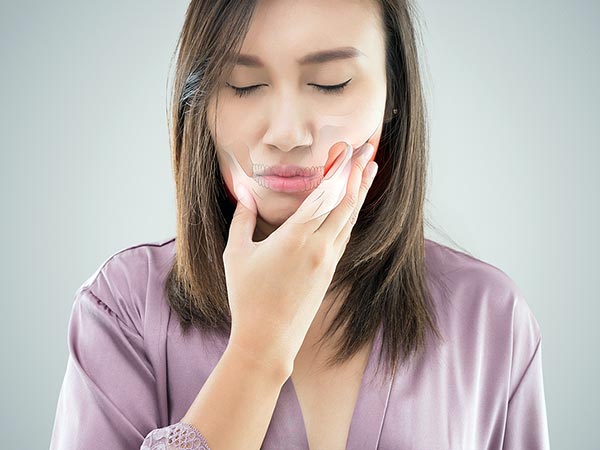
What is the TMJ?
The temporomandibular joint, or ‘TMJ’ is the hinged joint that connects the temporal bone of the skull to the jaw bone, or mandible; this is why it is aptly named ‘temporomandibular’ joint. We have two temporomandibular joints, located just in front of each ear.
The TMJ is a ‘synovial’ joint; like the knee or hip, the ability for movement is created by a combination of cartilage, ligaments, tendons, muscles and fibrous tissue capsules that contain synovial fluid. Synovial fluid provides necessary nutrients and lubrication for the joint; the fluid capsules (two for each TMJ) also serve as a cushion to help make jaw movement smooth and comfortable.

The TMJ has an ‘articular disc’, a thin, white oblong plate made up of cartilage and fibrous tissue, located in the center of the socket formed by the temporal bone and condyle (bony protrusion) of the mandible. The articular disc helps the mandible glide smoothly along the temporal bone during jaw movement.
The temporomandibular joints are the most used joints in the body; they allow the mouth to open and close (hinge function) and shift from side to side (slide function). While the TMJ are two joints, they actually work in unison to provide controlled movement of the jaw, allowing you to speak or chew food.
What are the Signs & Symptoms of a TMJ Disorder?
When the TMJ is not healthy, a patient may be diagnosed with TMJ Disorder, or TMD. Some cases of TMJ disorder or dysfunction are more obvious than others, for instance, when either or both jaw joints feel painful or make sounds (clicking, grating or popping) when the patient opens and closes their mouth. Jaw joint popping is not necessarily a sign of TMD, however, sometimes it just happens when we open wide or yawn.
In extreme cases of TMD, a ‘locked’ jaw joint can occur, restricting the patient from opening or closing their mouth altogether.
TMD can sometimes be difficult to diagnose due to symptoms that can be attributed to any number of health issues, including:
- Migraine headaches
- Facial pain
- Shoulder or neck pain
- A change in how the teeth come together
- Pain or difficulty when chewing
- Shooting pain going up the back of the head
- Ear pain, pressure or ringing in the ears
What causes TMD?
Pain from TMD occurs when the nerves and tissues around the TMJ become inflamed or damaged. There are a number of possible causes of TMD, which adds to the difficulty in diagnosis. A traumatic injury to the face or mouth (such as a car accident or sports injury) may be an explanation, or severe teeth grinding (bruxism) or teeth clenching could be an underlying cause of TMD.
Other health concerns may be linked as contributing factors of temporomandibular joint disorders, including:
- Arthritis
- High stress level
- Dental problems or sinus infections
- Chronic pain illnesses or autoimmune diseases
- Genetics
TMD is a complex condition; studies show that many TMD patients have additional serious illnesses (comorbidities), including heart disease, diabetes, asthma, fibromyalgia and others. TMD is also more common with women than men.
How is Temporomandibular Joint Disorder Diagnosed?
When you schedule a New Patient Consultation with Hartley Bridge TMJ & Dental Sleep Center, Macon dentist Dr. Leigh Bennett will meet with you personally for a detailed discussion of your symptoms and medical history. Dr. Bennett will combine your feedback and symptoms with a thorough examination and digital x-ray imaging to provide you with an assessment of your TMJ health.
Based on your symptoms and clinical findings, Dr. Bennett may refer you to medical professionals for further analysis of your bone and joint health or related physical conditions.
If you have been referred to Hartley Bridge TMJ & Dental Sleep Center by your physician for an evaluation of your temporomandibular joints or oral appliance therapy for management of obstructive sleep apnea, please Contact Us to schedule an appointment.
Treatments for Temporomandibular Joint Disorder
If a diagnosis of temporomandibular joint disorder (TMD) is confirmed following an examination and analysis by Dr. Bennett or medical professionals, treatment options may vary based on the level of joint injury.
Jaw pain and discomfort may be a temporary condition that can be addressed by eating a soft diet and keeping the jaw muscles relaxed for a few weeks. In other cases, such as bruxism (teeth grinding) and teeth clenching, oral appliance therapy may be recommended. Extreme cases of temporomandibular disorder or jaw trauma may require referral to medical specialists or the hospital emergency room. Learn more about Treatment Options for TMD.
Your Local Macon TMJ & TMD Dentist
Hartley Bridge TMJ & Dental Sleep Center dentist Dr. Leigh Bennett has years of experience and advanced training in the diagnosis and treatment of temporomandibular joint disorder (TMD).
Contact our Macon TMJ Team for more information or to schedule an appointment.